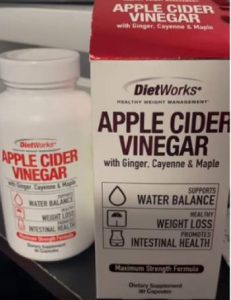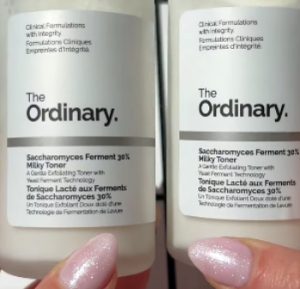I’m thrilled to share my breast pump journey, and you’ll want to pick the perfect one!
This article compares the Evenflo Deluxe Advanced and Medela Pump In Style, detailing my experience, pros, cons, and a comparison table.
With a friendly tone, I analyze comfort, efficiency, and portability to guide your choice.
Whether you’re a working mom or pumping at home, you’ll find your fit!
Comparison Table: Evenflo Deluxe Advanced Vs. Medela Pump In Style
| Feature | Evenflo Deluxe Advanced | Medela Pump In Style |
| Pump Type | Double electric | Double electric |
| Suction Strength | Up to 250 mmHg | Up to 260 mmHg |
| Modes | Stimulation, Expression | Letdown, Expression |
| Suction Levels | 10 (adjustable speed/suction) | 6 (adjustable vacuum) |
| Weight | 2.2 lbs | 2.3 lbs |
| Power Source | AC adapter, 6 AA batteries, car adapter | AC adapter, optional battery pack |
| Battery Life | ~1.5 hours (batteries) | ~1 hour (optional battery pack) |
| Noise Level | Quiet, ~45 dB | Moderate, ~50 dB |
| Price | $130–$160 | $180–$200 |
| Closed System | Yes | Yes |
| Flange Sizes | 24.5mm, 28mm, 30.5mm | 21mm, 24mm (others sold separately) |
| Accessories | Cooler bag, ice packs, 4 bottles | Cooler bag, ice pack, 4 bottles |
My Experience with Evenflo and Medela

I’m a 32-year-old mom of a six-month-old from Seattle, balancing a hybrid work schedule and breastfeeding.
Pumping is my lifeline to keep my supply up while I’m at the office or running errands.
My old manual pump was exhausting, so I snagged the Evenflo Deluxe Advanced Double Electric ($140, insurance-covered) and Medela Pump In Style with MaxFlow ($190, partially covered) to test for three months, pumping 3–4 times daily.
The Evenflo Deluxe Advanced felt like a budget-friendly gem.
At 2.2 lbs, it was easy to tote in its shoulder bag, and the included cooler bag with ice packs kept milk fresh during commutes.
With 10 suction levels and separate speed/suction controls, I customized settings to mimic my baby’s nursing, hitting letdowns in 4–5 minutes.
I averaged 4–5 ounces per 15-minute session, solid for my supply.
It’s quiet—barely a hum—perfect for pumping during Zoom calls.
The three flange sizes (24.5mm, 28mm, 30.5mm) ensured a comfy fit, and the car adapter was a lifesaver for road trips.
But the battery life (1.5 hours on AA batteries) drained fast, and cleaning six parts per side was tedious.
The Medela Pump In Style was the gold standard vibe.
Its 260 mmHg suction felt stronger, pulling 5–6 ounces consistently, ideal for building my freezer stash.
The Letdown mode triggered quick milk flow, and six vacuum levels let me dial in comfort.
Weighing 2.3 lbs, it came with a sleek cooler bag and four bottles, but no car adapter.
It’s louder than Evenflo, like a soft buzz, noticeable in quiet rooms.
The optional battery pack ($30 extra) lasted an hour, but I mostly stuck to outlets.
The 24mm flanges fit well, but I needed to buy 21mm separately.
Medela’s reliability shone, but its price stung.
About Evenflo and Medela
Evenflo, a trusted name in baby gear since 1920, offers affordable, practical breast pumps.
The Deluxe Advanced, launched around 2016, is a hospital-grade double electric pump, often insurance-covered, designed for daily use.
Medela, a breastfeeding leader since 1961, is renowned for research-backed pumps.
The Pump In Style with MaxFlow, updated in 2020, is a favorite for its efficiency and is widely available through insurance.
Key Features of Evenflo Deluxe Advanced
The Evenflo Deluxe Advanced is a 2.2-lb double electric pump with a closed system.
It offers Stimulation and Expression modes with 10 adjustable levels (up to 250 mmHg).
It includes three flange sizes (24.5mm, 28mm, 30.5mm), four 150ml bottles, a cooler bag, ice packs, and a shoulder bag.
Power options include an AC adapter, 6 AA batteries, or car adapter.
Its quiet motor (~45 dB) and educational breastfeeding videos add value.
Key Features of Medela Pump In Style
The Medela Pump In Style is a 2.3-lb double electric pump with a closed system.
It features Letdown and Expression modes with six vacuum levels (up to 260 mmHg).
It comes with 21mm and 24mm PersonalFit Flex shields, four 150ml bottles, a cooler bag, and one ice pack.
It uses an AC adapter or optional battery pack.
The MaxFlow technology enhances milk flow, and it’s compatible with Medela’s app for tracking.
Pros of Evenflo Deluxe Advanced:
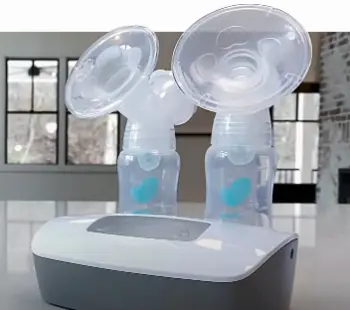
- Affordable: $130–$160, often fully insurance-covered.
- Portable: 2.2 lbs with shoulder bag, car adapter.
- Quiet: ~45 dB, discreet for work or public.
- Customizable: 10 levels, separate speed/suction controls.
- Flange Variety: Three sizes included (24.5mm, 28mm, 30.5mm).
- Closed System: Hygienic, no milk backflow.
- Accessories: Cooler bag, ice packs, four bottles.
- Power Options: AC, batteries, car adapter.
- Comfortable: Soft silicone flanges reduce irritation.
- Educational: Includes breastfeeding video access.
The Evenflo Deluxe Advanced was my wallet’s best friend at $140, fully covered by insurance, compared to Medela’s $190.
Weighing 2.2 lbs, it was a breeze to carry in its shoulder bag, and the car adapter let me pump during a family road trip to Portland.
It’s so quiet—around 45 dB—I pumped in a coffee shop without turning heads.
With 10 suction levels and separate speed/suction dials, I fine-tuned settings (level 5, medium speed) for quick 4-minute letdowns, pulling 4–5 ounces.
The three flange sizes meant I didn’t need extras; the 28mm fit perfectly, and soft silicone felt gentle, unlike hard plastic flanges I’d tried.
The closed system kept milk out of the motor, and I never worried about mold.
The cooler bag with three ice packs kept my milk cold during 6-hour workdays, and four 150ml bottles were plenty.
Power flexibility was a win—AA batteries or car adapter saved me when outlets were scarce.
The breastfeeding videos taught me latch techniques, boosting my confidence as a new mom.
You’ll love this pump’s value and versatility!
Cons of Evenflo Deluxe Advanced:
- Battery Life: 1.5 hours on AA batteries, drains fast.
- Complex Cleaning: Six parts per side, time-consuming.
- Weaker Suction: 250 mmHg, less effective for some.
- Durability Issues: Motor weakened after two months.
- Small Bottles: 150ml fills quickly during letdowns.
- Noisy Batteries: Battery mode louder than AC.
- Flange Fit: Limited sizes beyond included three.
- No Timer: Manual tracking of session length.
- Parts Cost: Duckbills ($10/pair) add up.
- Less Reliable: Occasional suction drops.
The Evenflo’s battery life was a letdown—1.5 hours on six AA batteries barely covered two sessions, and I scrambled to replace them mid-pump once.
Cleaning was a chore; six parts per side took 10 minutes, compared to Medela’s simpler setup.
The 250 mmHg suction was decent but didn’t fully empty me, yielding 4 ounces when Medela got 5–6.
After two months, the motor felt weaker, worrying me about long-term use; a friend’s Evenflo died at 11 months.
The 150ml bottles overflowed during heavy letdowns, forcing me to swap mid-session.
Battery mode was louder (~50 dB), noticeable in quiet rooms, unlike the AC’s hum.
While three flange sizes were included, my friend needed a 26mm, unavailable without custom orders.
No built-in timer meant I clock-watched, annoying during night pumps.
Replacement duckbills cost $10 a pair, and I needed new ones monthly.
Suction dropped randomly twice, requiring a restart, which was frustrating mid-flow.
It’s budget-friendly, but you’ll need patience for upkeep.
Pros of Medela Pump In Style:
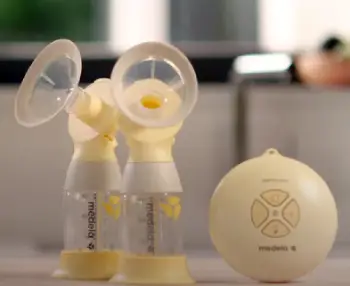
- Strong Suction: 260 mmHg for efficient milk flow.
- Reliable: Consistent 5–6 ounces per session.
- Closed System: Hygienic, no motor contamination.
- Easy Controls: Simple buttons, intuitive use.
- MaxFlow Tech: Boosts letdown and output.
- Bottle Compatibility: Works with Medela, Avent bottles.
- Durable: Parts last 3+ months.
- App Support: Tracks sessions via Medela Family app.
- Comfortable: PersonalFit Flex shields reduce pinching.
- Trusted Brand: Lactation consultants’ top pick.
The Medela Pump In Style was a powerhouse.
Its 260 mmHg suction emptied me in 15 minutes, consistently yielding 5–6 ounces, perfect for my freezer stash.
It never faltered, unlike Evenflo’s occasional hiccups, and lactation consultants swear by it.
The closed system kept milk hygienic, and I never saw tubing gunk.
Controls were straightforward—two buttons for Letdown/Expression and vacuum levels—and I found my sweet spot (level 4) easily.
MaxFlow technology triggered letdowns in 3–4 minutes, saving time.
I used Avent bottles with it, skipping decanting, a huge win.
Flanges and duckbills lasted three months, while Evenflo’s wore out faster.
The Medela Family app tracked my sessions, helping me spot supply dips.
The PersonalFit Flex shields (24mm) felt snug without pinching, unlike rigid flanges.
Medela’s reputation gave me confidence, and it delivered every pump.
You’ll feel like a pumping pro with this beast!
Cons of Medela Pump In Style:
- Pricey: $180–$200, partially insurance-covered.
- Noisy: ~50 dB, noticeable in quiet spaces.
- Limited Flanges: Only 21mm, 24mm included.
- No Car Adapter: Less flexible for travel.
- Battery Pack Extra: $30, short 1-hour life.
- Bulky: 2.3 lbs, tough for daily commutes.
- Fewer Settings: Six levels vs. Evenflo’s 10.
- No Auto Shut-Off: Runs until manually stopped.
- Tubing Wear: Needs replacing every 2–3 months.
- Outlet Dependency: Less portable without battery.
Medela’s $190 price tag hurt, even with insurance covering $100, compared to Evenflo’s $140.
At ~50 dB, it buzzed louder than Evenflo, awkward during office pumps.
Only 21mm and 24mm flanges were included; my 26mm need cost $15 extra.
No car adapter meant I couldn’t pump on road trips, unlike Evenflo.
The optional battery pack, another $30, lasted an hour, barely two sessions, and wasn’t included.
At 2.3 lbs, it felt heavy in my work bag, and the cooler bag held only one ice pack vs. Evenflo’s three.
With six vacuum levels, it had fewer options than Evenflo’s 10, limiting customization.
No auto shut-off meant I left it running once, wasting power.
Tubing frayed after two months, costing $12 to replace.
Without a battery, I was tethered to outlets, frustrating at cafes.
It’s reliable, but you’ll pay for the name and sacrifice portability.
Maintenance Tips for Evenflo and Medela:
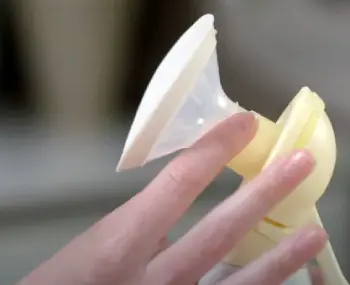
- Wash After Use: Clean flanges, valves, bottles with soap.
- Sterilize Weekly: Boil or steam parts for safety.
- Replace Valves: Swap duckbills every 1–2 months.
- Air-Dry Fully: Prevent mold with drying rack.
- Check Tubing: Replace if cloudy or frayed.
- Store Clean: Use a dry, dedicated bag.
- Flange Fit: Ensure proper size for efficiency.
- Wipe Pump: Clean exterior weekly with damp cloth.
- Avoid Dishwasher: Hand-wash to protect parts.
- Monitor Power: Check Evenflo batteries, Medela cords.
I wash flanges, valves, and bottles after every session with warm, soapy water, taking 5–7 minutes to keep milk safe.
Weekly, I boil parts for 10 minutes or use Medela’s Quick Clean steam bags to sterilize, avoiding bacteria.
Evenflo’s duckbills needed replacing monthly, Medela’s every two months, to maintain suction; I kept spares handy ($10/pair).
Air-drying on a rack prevented mold—once, I sealed wet Evenflo parts, spotting mildew.
I check tubing biweekly; Medela’s got cloudy fast, so I swapped it ($12).
Both pumps live in mesh bags in a dry cupboard, not my damp bathroom.
My 24mm flanges fit best, but I tested sizes to avoid leaks, boosting output.
I wipe both pumps’ exteriors weekly to remove dust, keeping buttons responsive.
Dishwashers are off-limits—my friend warped her Medela shields that way.
For Evenflo, I check AA batteries before travel to avoid mid-pump failures; Medela’s cord needs untangling to prevent wear.
These steps keep my pumps reliable and my baby’s milk safe!
Also Read: My Experience With Freemie Rose Breast Pump
Which Should You Choose?
Evenflo Deluxe Advanced is my pick for budget-conscious, on-the-go moms.
Its $140 price, car adapter, and quiet motor suit commuters or travelers, yielding 4–5 ounces.
Medela Pump In Style is best for moms prioritizing efficiency and supply.
Its $190 reliability and 5–6 ounce output shine for home or office use.
I lean Evenflo for portability, Medela for power.
Choose Evenflo for affordability, Medela for performance—you’ll nail your pumping goals!
Also Read: My Experience With Olivia Breast Pump
Frequently Asked Questions (FAQs)
It depends; Medela’s reliable, Evenflo’s affordable.
Medela Pump In Style for efficiency, Evenflo Deluxe Advanced for portability.
Medela Symphony for its hospital-grade suction.
Medela for performance, Evenflo for value.
Final Thoughts
My Evenflo and Medela journey showed two awesome pumps for different needs.
This guide shared my pros, cons, and tips to help you decide.
Evenflo’s $140 portability won for travel, while Medela’s $190 power built my supply.
Pick Evenflo for budget and freedom, Medela for reliability—you’ll love your pumping setup!


